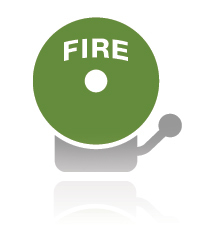Software Application Rollout Training (Part 2)
This is the second installment in a three-part series on responding to the challenge of software application rollout training. Or as some may call it..."What to do when the house is on fire."

Reduce, Reuse, Recycle
Reduce: Keep the training content concise and efficient. For example: where possible, don't use screenshots since they will change multiple times before release.
Reuse: Create templates early in the project so they can be reused for each training component. You'll need templates and shells for:
- Facilitator and student guides
- PowerPoint slides
- Job aids, posters and mobile media items
- eLearning or webinar tools
Use Placeholders for Unstable or 'In Progress' Elements of the Software
Experience tells us that by the time you were called to this fire, the software likely is somewhere between 50% and 80% complete, and many or most components are still pretty unstable. To accommodate this moving target:
- Build the design for your training, and begin materials development as soon as reasonable.
- Know that your first pass through will have lots of holes and will be filled with placeholders. If you wait until everything is stable, you will not likely have enough time to get everything done. Fill in the holes and replace the placeholders as the content becomes available.
- Verify that the newly added content aligns with the content already in place.
- Stay in frequent contact with your IT developer SME, and build a partnership of mutual respect and trust. Help the developer understand the importance his or her work has on training development. Encourage the SME to notify you of important development events.
Develop in Small(er) Chunks
Small(er) chunks of training content become even more important in a software application rollout training scenario. Here are some good reasons to keep the chunks as small as you can:
- If the software changes, it is more likely to be contained to one small module.
- Small chunk development is easier for SMEs to review, so you are less likely to have SME delays as a result.
- You can more easily divide the work among multiple learning designers who can work in parallel.
- Smaller chunks are more manageable and lend to the blended experience. For example, one chunk may be in .pdf, another in a webinar and another in a Captivate 'show me' module. You can break up the information in smaller cognitive loads, and you can make an experience that is engaging without a lot of extra time and/or expense.
Next Time: In Part lll, the final installment of this article, we will conclude the discussion with rapid prototyping, progress reporting and a focus on the bigger picture.
Continue reading:
Software Application Rollout (Part 3) →
Software Application Rollout (Part 1) →



